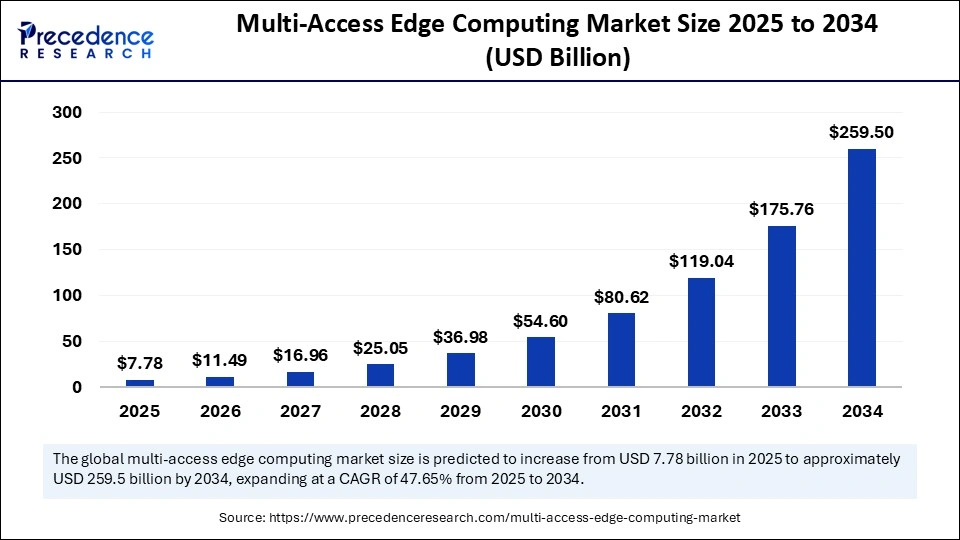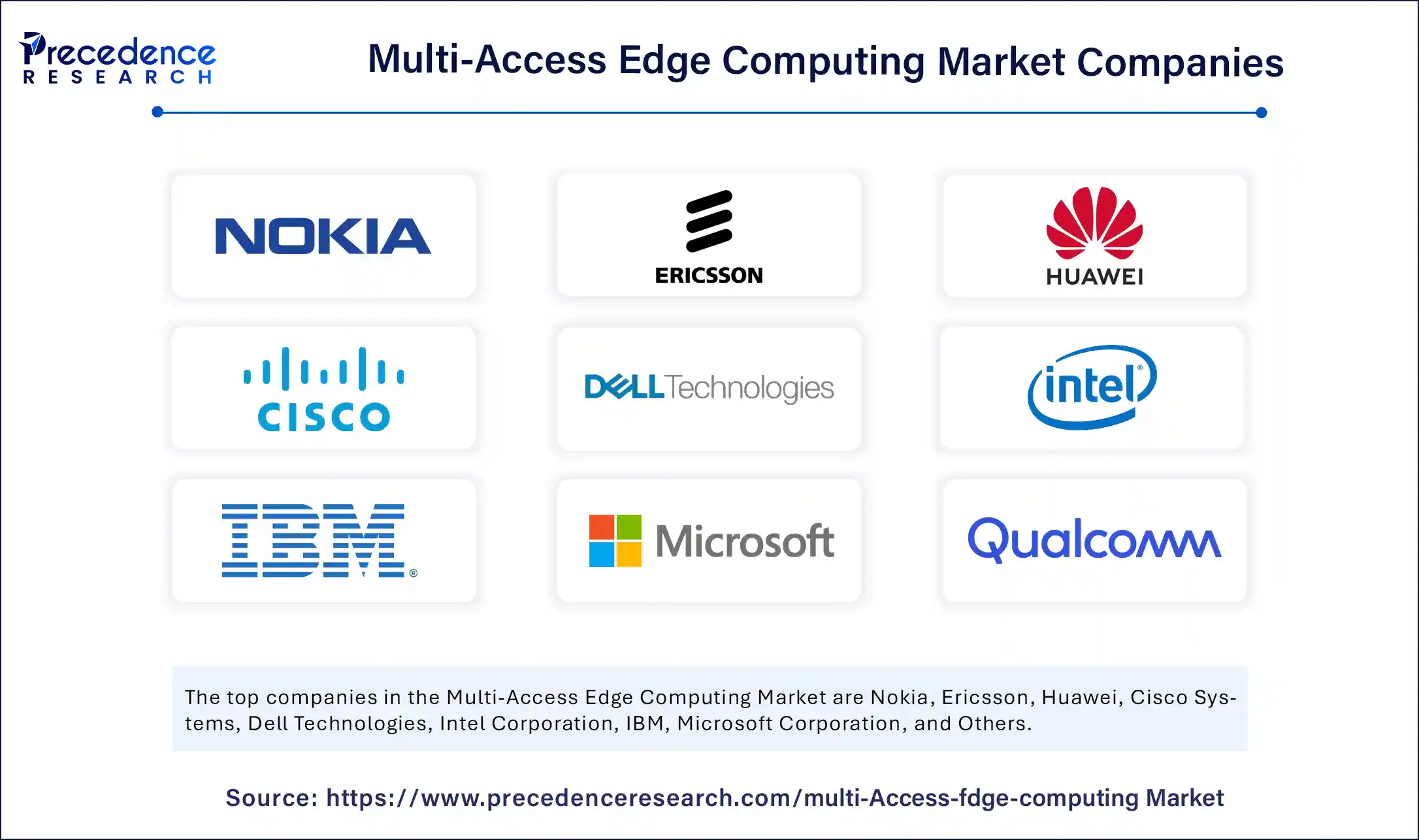The global multi-access edge computing (MEC) market, valued at USD 5.27 billion in 2024, is forecasted to surge to approximately USD 259.50 billion by 2034, growing at an impressive CAGR of 47.65% from 2025 to 2034. This explosive growth stems primarily from the widespread adoption of 5G networks, the increasing demand for low-latency data processing, and the rising integration of autonomous vehicles, Internet of Things (IoT) applications, and smart city projects, all supported by emerging cloud-native and AI-driven technologies.

Multi-Access Edge Computing Market Key Insights
-
The MEC market was valued at USD 5.27 billion in 2024 and is predicted to reach USD 259.50 billion by 2034.
-
North America dominated the market in 2024, with the United States alone contributing USD 1.29 billion.
-
Asia Pacific is the fastest-growing region, led by China, India, and Southeast Asia, driven by rapid 5G deployment and massive IoT adoption.
-
Software leads the market segment by offering orchestration and real-time processing capabilities essential for edge infrastructure.
-
Telecom operators dominate end-user segments, leveraging their 5G infrastructure.
-
Industrial automation is the leading application sector due to the need for real-time processing in manufacturing.
-
Major companies driving innovation include Microsoft, IBM, Google, ADLINK Technology Inc., Advantech Co. Ltd., Huawei Technologies, Juniper Networks, and SAGUNA.
What is Driving the Multi-Access Edge Computing Market Growth?
Multi-access edge computing brings cloud capabilities closer to users by processing data at the network’s edge, substantially reducing response times and bandwidth usage for ultra-low latency and high-bandwidth applications. The rapid rollout of 5G networks acts as a critical enabler, allowing data to be processed locally at unprecedented speeds. Enterprises increasingly adopt private edge infrastructures and integrate AI-powered analytics, supporting revolutionary applications like autonomous vehicles, virtual reality, and industrial IoT. These factors collectively fuel the sector’s robust CAGR of 47.65%.
AI’s Transformative Role in Multi-Access Edge Computing
Artificial intelligence dramatically enhances MEC capabilities by enabling decentralized, real-time data processing and decision-making at the edge. This local processing reduces the need for transmitting bulky data to centralized clouds, cutting latency and preserving bandwidth. AI applied at the edge is paramount for sensitive, latency-critical use cases like autonomous driving and smart manufacturing, ensuring faster, privacy-aware operations. By minimizing cloud resource dependency, edge AI also facilitates scalable and cost-effective deployments that support an expanding ecosystem of connected devices.
What are the Key Market Growth Factors?
The multi-access edge computing market’s unprecedented expansion is driven by:
-
The global rollout of 5G technology, providing the ultra-low latency and broad bandwidth essential for real-time applications.
-
Growing adoption of IoT devices requiring instantaneous data processing and response.
-
Increasing demand for edge AI and real-time analytics to optimize operational efficiency across industries.
-
Deployment of private edge infrastructures by enterprises seeking improved security and performance.
-
Government initiatives promoting smart cities and digital transformation, particularly in Asia Pacific and North America.
Multi-Access Edge Computing Market Scope
| Report Coverage | Details |
| Market Size by 2034 | USD 259.50 Billion |
| Market Size in 2025 | USD 7.78 Billion |
| Market Size in 2024 | USD 5.27 Billion |
| Market Growth Rate from 2025 to 2034 | CAGR of 47.65% |
| Dominating Region | North America |
| Fastest Growing Region | Asia Pacific |
| Base Year | 2024 |
| Forecast Period | 2025 to 2034 |
| Segments Covered | Component, Deployment Type, Application, End-user, and Region |
| Regions Covered | North America, Europe, Asia-Pacific, Latin America, and Middle East & Africa |
What Are the Emerging Opportunities and Trends in MEC?
Are there new applications emerging from MEC adoption?
Applications such as autonomous vehicles, AR/VR immersive experiences, and advanced industrial automation are rapidly expanding, all requiring real-time data analysis and minimal latency. Smart city projects also gain momentum by leveraging MEC for traffic control, public safety, and environmental monitoring.
How is the synergy between 5G and MEC creating new business models?
The intersection of 5G and MEC enables telecom operators and service providers to offer localized, high-speed services that optimize network traffic and open revenue streams in gaming, media, and enterprise IoT. This alignment fosters innovative consumption-based pricing and managed service offerings.
Which industry sectors are leading MEC adoption?
Industrial automation, telecommunications, healthcare, and smart cities dominate MEC use, driven by the need for deterministic, low-latency computing to handle mission-critical applications like robotics, remote surgeries, and real-time monitoring.
Multi-Access Edge Computing Market Regional and Market Segment Analysis
North America currently leads due to advanced infrastructure, early 5G adoption, and heavy investments by tech giants like Microsoft, IBM, and Google. The U.S. MEC market alone was valued at USD 1.29 billion in 2024 and is projected to grow exponentially by 2034.
Asia Pacific is the fastest-growing region, propelled by aggressive government backing for smart cities, vast industrial digitization, and the largest scale of 5G adoption globally, especially in China, India, and Southeast Asia.
Europe is also advancing steadily, supported by digital transformation policies and growing demand for localized data processing in sectors like automotive, energy, and public services.
By component, software solutions lead, enabling flexible orchestration and AI at the edge, while services are rapidly growing as companies outsource complex deployments. The cloud-based deployment segment dominates due to hybrid edge-cloud models that blend centralized control with localized processing.
Major industrial automation applications harness MEC to improve operational efficiencies, predictive maintenance, and robotics coordination, while telecom operators leverage MEC to optimize 5G service delivery and create new revenue streams.
Multi-Access Edge Computing Market Companies

- Nokia
- Ericsson
- Huawei
- Cisco Systems
- Dell Technologies
- Intel Corporation
- IBM
- Microsoft Corporation
- Qualcomm Technologies
- Advantech Co., Ltd.
- Juniper Networks
- HPE (Hewlett Packard Enterprise)
- Amdocs
- Samsung Electronics
- Orange S.A.
- ZTE Corporation
- Arista Networks
- Cradlepoint
- Fastly, Inc.
- Wind River
What are the Challenges and Cost Pressures Facing MEC?
Despite its immense potential, MEC faces considerable hurdles such as:
-
High initial capital expenditure for distributed edge infrastructure.
-
Complex integration challenges due to the lack of standardized solutions.
-
Data security, privacy, and regulatory compliance concerns.
-
Uncertain ROI and fragmented monetization models, especially for SMEs.
Case Study: Accelerating Autonomous Vehicle Deployment with Edge AI
A leading telecom operator partnered with a global automotive manufacturer to deploy MEC-enabled edge AI platforms across urban test zones. This deployment enabled real-time data processing critical for autonomous vehicle navigation and communication, drastically reducing latency from cloud transfer delays and enhancing safety. The project demonstrated a 30% improvement in response times and a significant reduction in network congestion, proving MEC’s value in mission-critical IoT applications.
Read Also: Storage Area Network (SAN) Market
You can place an order or ask any questions. Please feel free to contact us at sales@precedenceresearch.com |+1 804 441 9344
- Multi-Access Edge Computing Market Size to Reach USD 259.50 Billion by 2034 - September 12, 2025
- Storage Area Network Market Size to Surpass USD 36.63 Billion by 2034 - September 12, 2025
- Ambient Computing Market Size to Reach USD 448.89 Billion by 2034 - September 12, 2025
